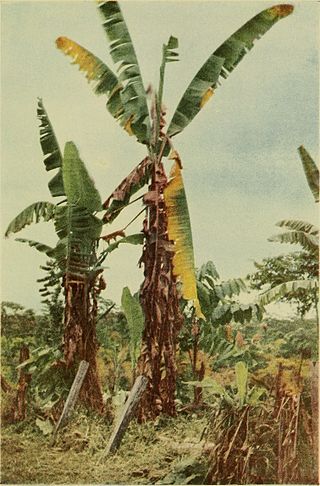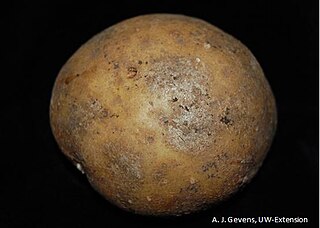
Corn smut is a plant disease caused by the pathogenic fungus Ustilago maydis. One of several cereal crop pathogens called smut, the fungus forms galls on all above-ground parts of corn species such as maize and teosinte. The infected corn is edible; in Mexico, it is considered a delicacy called huitlacoche, often eaten as a filling in quesadillas and other tortilla-based foods, as well as in soups.

Panama disease is a plant disease that infects banana plants. It is a wilting disease caused by the fungus Fusarium oxysporum f. sp. cubense (Foc). The pathogen is resistant to fungicides and its control is limited to phytosanitary measures.

Ustilago is a genus of approximately 200 smut fungi, which are parasitic on grasses. 170 species are accepted by Wijayawardene et al. 2020;

Cochliobolus miyabeanus is a fungus that causes brown spot disease in rice.

Ceratocystis fimbriata is a fungus and a plant pathogen, attacking such diverse plants as the sweet potato and the tapping panels of the Para rubber tree. It is a diverse species that attacks a wide variety of annual and perennial plants. There are several host-specialized strains, some of which, such as Ceratocystis platani that attacks plane trees, are now described as distinct species.

Acremonium is a genus of fungi in the family Hypocreaceae. It used to be known as Cephalosporium.

Gibberella zeae, also known by the name of its anamorph Fusarium graminearum, is a fungal plant pathogen which causes fusarium head blight (FHB), a devastating disease on wheat and barley. The pathogen is responsible for billions of dollars in economic losses worldwide each year. Infection causes shifts in the amino acid composition of wheat, resulting in shriveled kernels and contaminating the remaining grain with mycotoxins, mainly deoxynivalenol (DON), which inhibits protein biosynthesis; and zearalenone, an estrogenic mycotoxin. These toxins cause vomiting, liver damage, and reproductive defects in livestock, and are harmful to humans through contaminated food. Despite great efforts to find resistance genes against F. graminearum, no completely resistant variety is currently available. Research on the biology of F. graminearum is directed towards gaining insight into more details about the infection process and reveal weak spots in the life cycle of this pathogen to develop fungicides that can protect wheat from scab infection.

Verticillium dahliae is a fungal plant pathogen. It causes verticillium wilt in many plant species, causing leaves to curl and discolor. It may cause death in some plants. Over 400 plant species are affected by Verticillium complex.
Acremonium strictum is an environmentally widespread saprotroph species found in soil, plant debris, and rotting mushrooms. Isolates have been collected in North and Central America, Asia, Europe and Egypt. A. strictum is an agent of hyalohyphomycosis and has been identified as an increasingly frequent human pathogen in immunosuppressed individuals, causing localized, disseminated and invasive infections. Although extremely rare, A. strictum can infect immunocompetent individuals, as well as neonates. Due to the growing number of infections caused by A. strictum in the past few years, the need for new medical techniques in the identification of the fungus as well as for the treatment of human infections has risen considerably.

Sarocladium oryzae (Sawada) is a plant pathogen causing the Sheath rot disease of rice and Bamboo blight of Bambusoideae spp. in Asia.
Sporisorium reilianum Langdon & Full., (1978), previously known as Sphacelotheca reiliana, and Sporisorium reilianum, is a species of biotrophic fungus in the family Ustilaginaceae. It is a plant pathogen that infects maize and sorghum.

Helminthosporium solani is a fungal plant pathogen responsible for the plant disease known as silver scurf. Silver scurf is a blemish disease, meaning the effect it has on tubers is mostly cosmetic and affects "fresh market, processing and seed tuber potatoes." There are some reports of it affecting development, meaning growth and tuber yield. This is caused by light brown lesions, which in turn change the permeability of tuber skin and then it causes tuber shrinkage and water loss, which finally causes weight loss. The disease has become economically important because silver scurf affected potatoes for processing and direct consumption have been rejected by the industry. The disease cycle can be divided into two stages: field and storage. It is mainly a seed borne disease and the primary source of inoculum is mainly infected potato seed tubers. Symptoms develop and worsen in storage because the conditions are conducive to sporulation. The ideal conditions for the spread of this disease are high temperatures and high humidity. There are also many cultural practices that favor spread and development. There are multiple ways to help control the disease.

A wilt disease is any number of diseases that affect the vascular system of plants. Attacks by fungi, bacteria, and nematodes can cause rapid killing of plants, large tree branches or even entire trees.

Grey leaf spot (GLS) is a foliar fungal disease that affects maize, also known as corn. GLS is considered one of the most significant yield-limiting diseases of corn worldwide. There are two fungal pathogens that cause GLS: Cercospora zeae-maydis and Cercospora zeina. Symptoms seen on corn include leaf lesions, discoloration (chlorosis), and foliar blight. Distinct symptoms of GLS are rectangular, brown to gray necrotic lesions that run parallel to the leaf, spanning the spaces between the secondary leaf veins. The fungus survives in the debris of topsoil and infects healthy crops via asexual spores called conidia. Environmental conditions that best suit infection and growth include moist, humid, and warm climates. Poor airflow, low sunlight, overcrowding, improper soil nutrient and irrigation management, and poor soil drainage can all contribute to the propagation of the disease. Management techniques include crop resistance, crop rotation, residue management, use of fungicides, and weed control. The purpose of disease management is to prevent the amount of secondary disease cycles as well as to protect leaf area from damage prior to grain formation. Corn grey leaf spot is an important disease of corn production in the United States, economically significant throughout the Midwest and Mid-Atlantic regions. However, it is also prevalent in Africa, Central America, China, Europe, India, Mexico, the Philippines, northern South America, and Southeast Asia. The teleomorph of Cercospora zeae-maydis is assumed to be Mycosphaerella sp.

Southern corn leaf blight (SCLB) is a fungal disease of maize caused by the plant pathogen Bipolaris maydis.

Physoderma maydis is a species of fungus in the family Physodermataceae. It is a pathogen of the maize, causing a disease known as brown spot of maize or brown spot of corn. This species was first labeled in 1910 in India, then again a year later in Illinois.

Stenocarpella maydis (Berk.) Sutton is a plant pathogenic fungus and causal organism of diplodia ear and stalk rot. Corn and canes are the only known hosts to date. No teleomorph of the fungus is known.
Sarocladium kiliense is a saprobic fungus that is occasionally encountered as a opportunistic pathogen of humans, particularly immunocompromised and individuals. The fungus is frequently found in soil and has been linked with skin and systemic infections. This species is also known to cause disease in the green alga, Cladophora glomerata as well as various fruit and vegetable crops grown in warmer climates.
Phyllachora maydis is a plant pathogen causing ascomycete diseases in maize/corn, and is more commonly referred to as tar spot. Identified by the distinctive development of stroma, this pathogen in itself is of little economic importance in the production of corn. However, the accompanying fungal infection of Monographella maydis, identified by “fish-eye” lesions, was claimed to cause significant foliar damage and subsequently yield reduction. As of 2021 there is insufficient information about this pathogen and its management.

Cryphalus mangiferae, the mango bark beetle, is a tiny tropical bark beetle which attacks mango trees. It is often cited as a vector of plant pathogenic fungi infecting mango trees. The species belongs to the family Curculionidae, subfamily Scolytinae.
















